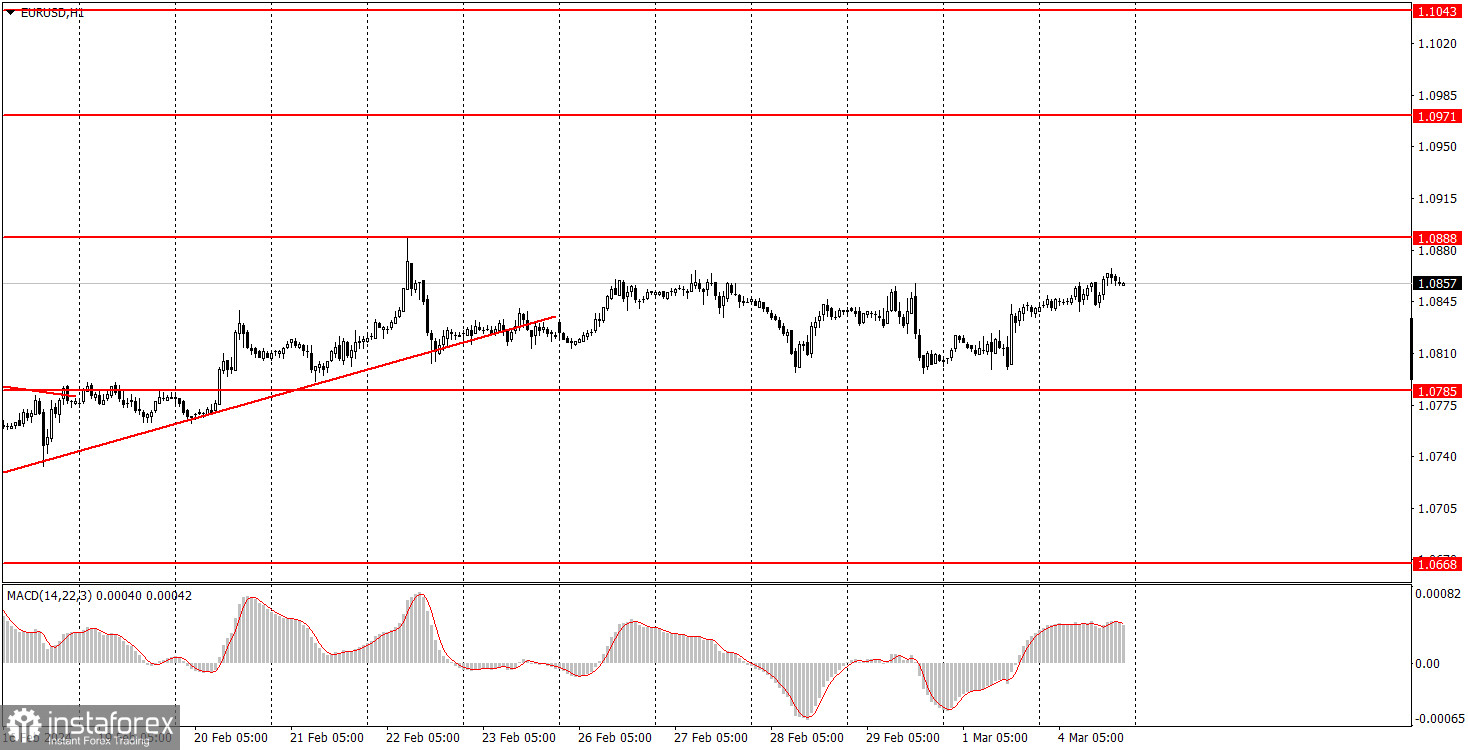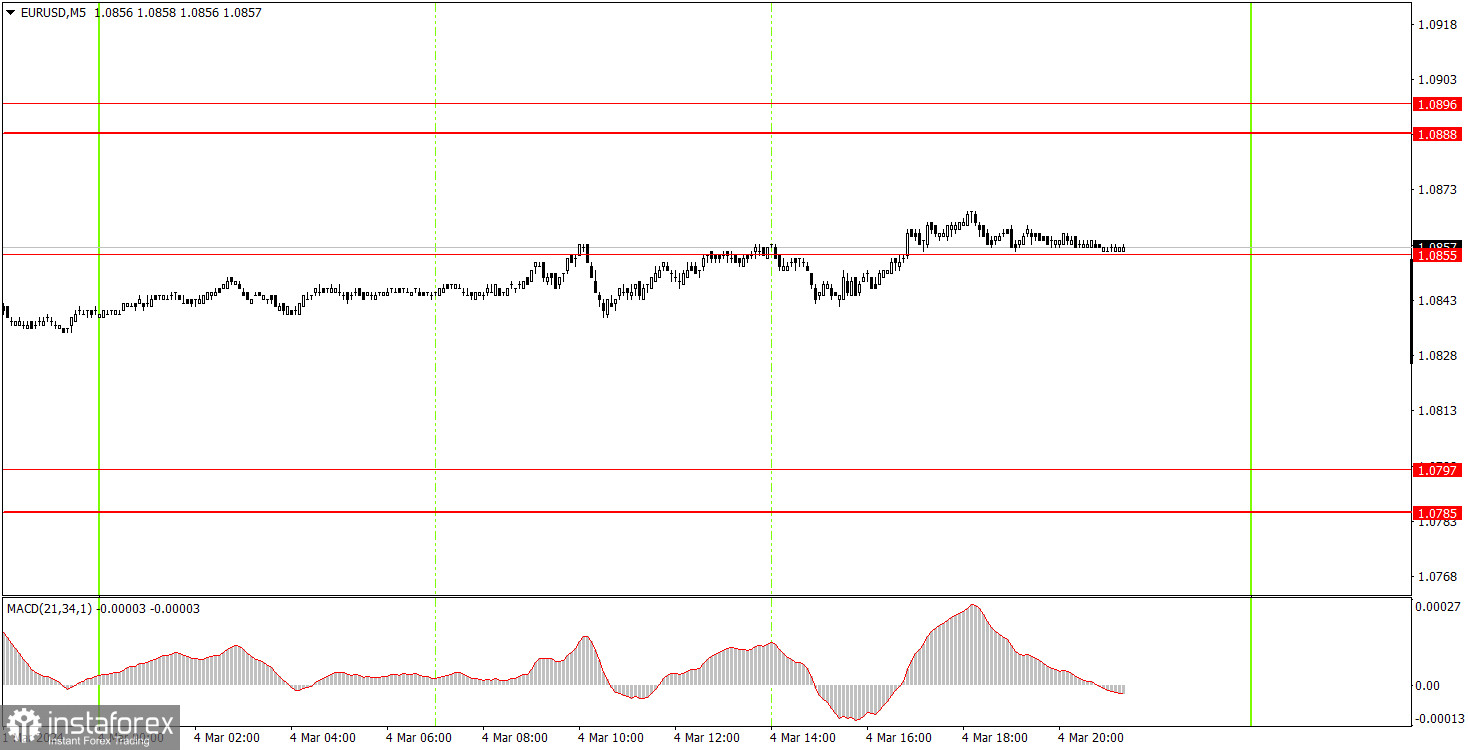Analyzing Monday's trades:
EUR/USD on 1H chart

EUR/USD continued to trade within a sideways channel on Monday. The price has been moving sideways between the levels of 1.0785 and 1.0888 for almost two weeks. Nothing has changed. Despite trading higher during the day, it had no impact, and the daily volatility barely exceeded 30 pips. There were no fundamental or macroeconomic backgrounds, so novice traders had nothing to analyze or work on. We witnessed another "boring Monday," but lately, such occurrences have also been happening on Tuesdays, Wednesdays, Thursdays, and Fridays as well...
EUR/USD on 5M chart

No signals were formed on the 5-minute timeframe. We added a new level (1.0855), which wasn't present on Monday. Perhaps, several signals may form around this mark on Tuesday, but we have to remind you that not only is trading in a flat a risky endeavor but often pointless, as the price is practically standing still.
Trading tips on Tuesday:
On the hourly chart, EUR/USD entered a total flat phase. We still expect the euro to resume its decline, which, in our opinion, should continue for quite some time, but the market is in no hurry at all. You may consider selling the euro after the price has settled below the level of 1.0785. Until then, the flat may persist.
The key levels on the 5M chart are 1.0568, 1.0611-1.0618, 1.0668, 1.0725, 1.0785-1.0797, 1.0888-1.0896, 1.0940, 1.0971-1.0981, 1.1011, 1.1043, 1.1091. On Tuesday, the eurozone will publish secondary reports on the Services Purchasing Managers' Index (PMI) data of Germany and the EU (second estimates). In the United States, the situation will be a bit more interesting, as the ISM Services PMI will be released. ISM indices are always potentially strong market movers. At the moment, it may not be as impactful, but it's still worth paying attention to this report.
Basic trading rules:
1) Signal strength is determined by the time taken for its formation (either a bounce or level breach). A shorter formation time indicates a stronger signal.
2) If two or more trades around a certain level are initiated based on false signals, subsequent signals from that level should be disregarded.
3) In a flat market, any currency pair can produce multiple false signals or none at all. In any case, the flat trend is not the best condition for trading.
4) Trading activities are confined between the onset of the European session and mid-way through the U.S. session, after which all open trades should be manually closed.
5) On the 30-minute timeframe, trades based on MACD signals are only advisable amidst substantial volatility and an established trend, confirmed either by a trendline or trend channel.
6) If two levels lie closely together (ranging from 5 to 15 pips apart), they should be considered as a support or resistance zone.
How to read charts:
Support and Resistance price levels can serve as targets when buying or selling. You can place Take Profit levels near them.
Red lines represent channels or trend lines, depicting the current market trend and indicating the preferable trading direction.
The MACD(14,22,3) indicator, encompassing both the histogram and signal line, acts as an auxiliary tool and can also be used as a signal source.
Significant speeches and reports (always noted in the news calendar) can profoundly influence the price dynamics. Hence, trading during their release calls for heightened caution. It may be reasonable to exit the market to prevent abrupt price reversals against the prevailing trend.
Beginning traders should always remember that not every trade will yield profit. Establishing a clear strategy coupled with sound money management is the cornerstone of sustained trading success.
 English
English 
 Русский
Русский Bahasa Indonesia
Bahasa Indonesia Bahasa Malay
Bahasa Malay ไทย
ไทย Español
Español Deutsch
Deutsch Български
Български Français
Français Tiếng Việt
Tiếng Việt 中文
中文 বাংলা
বাংলা हिन्दी
हिन्दी Čeština
Čeština Українська
Українська Română
Română

